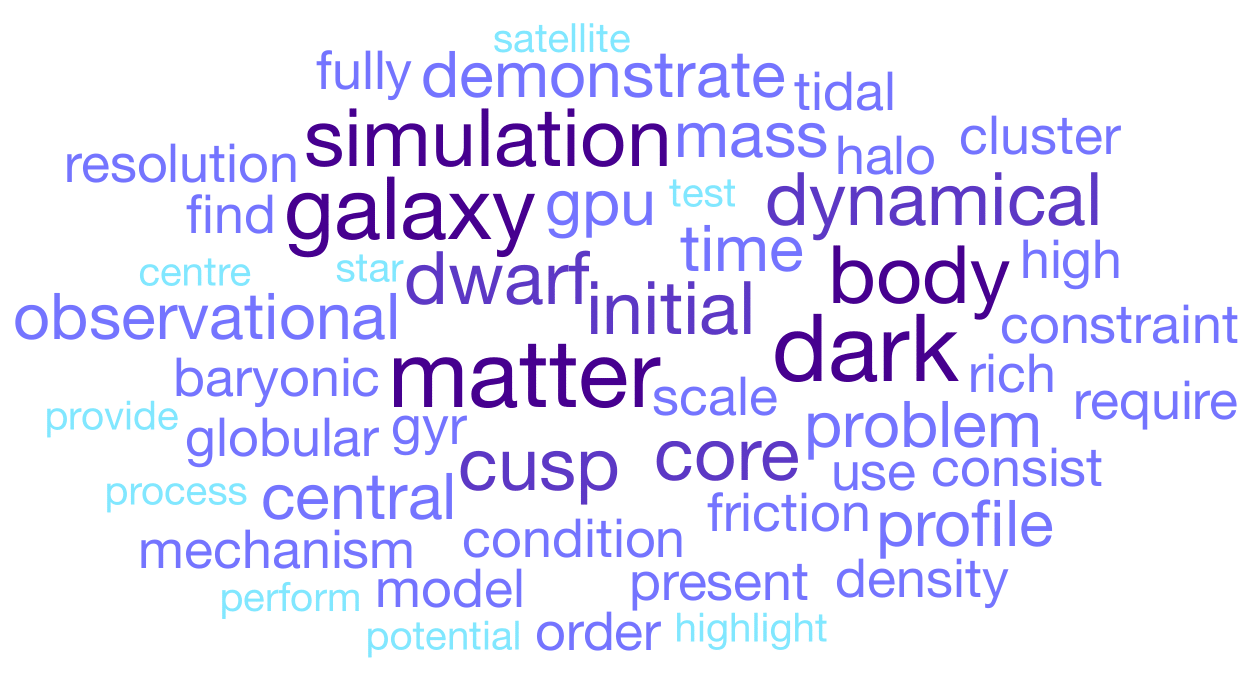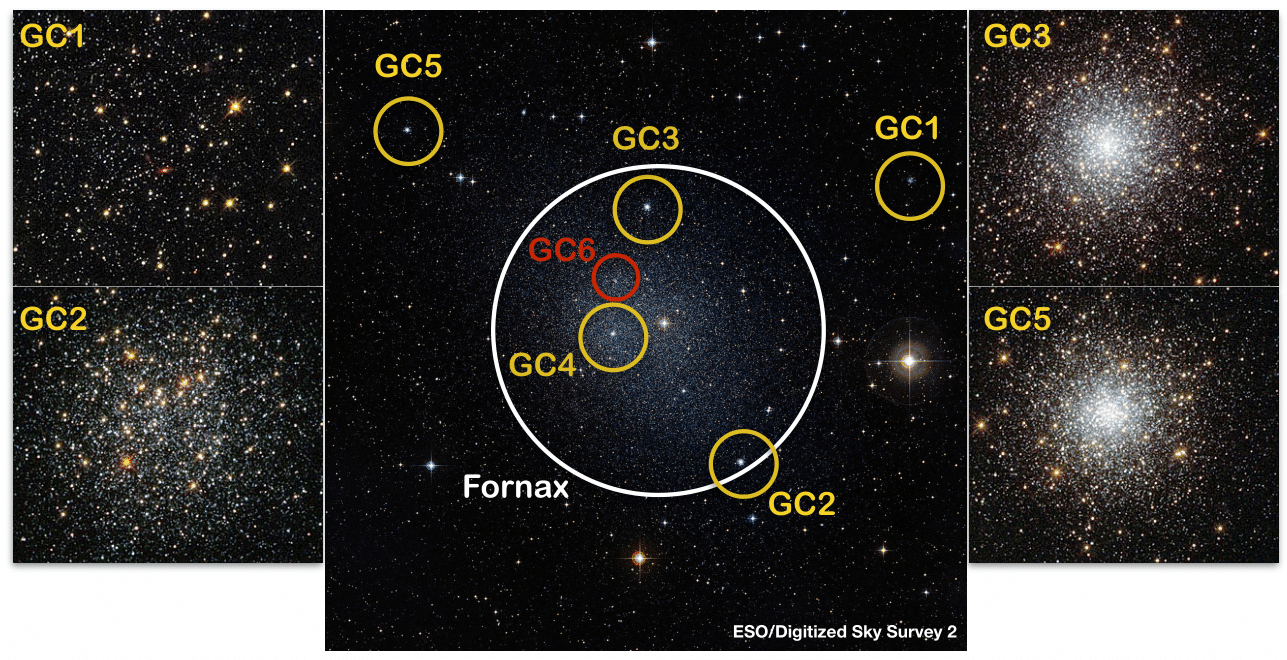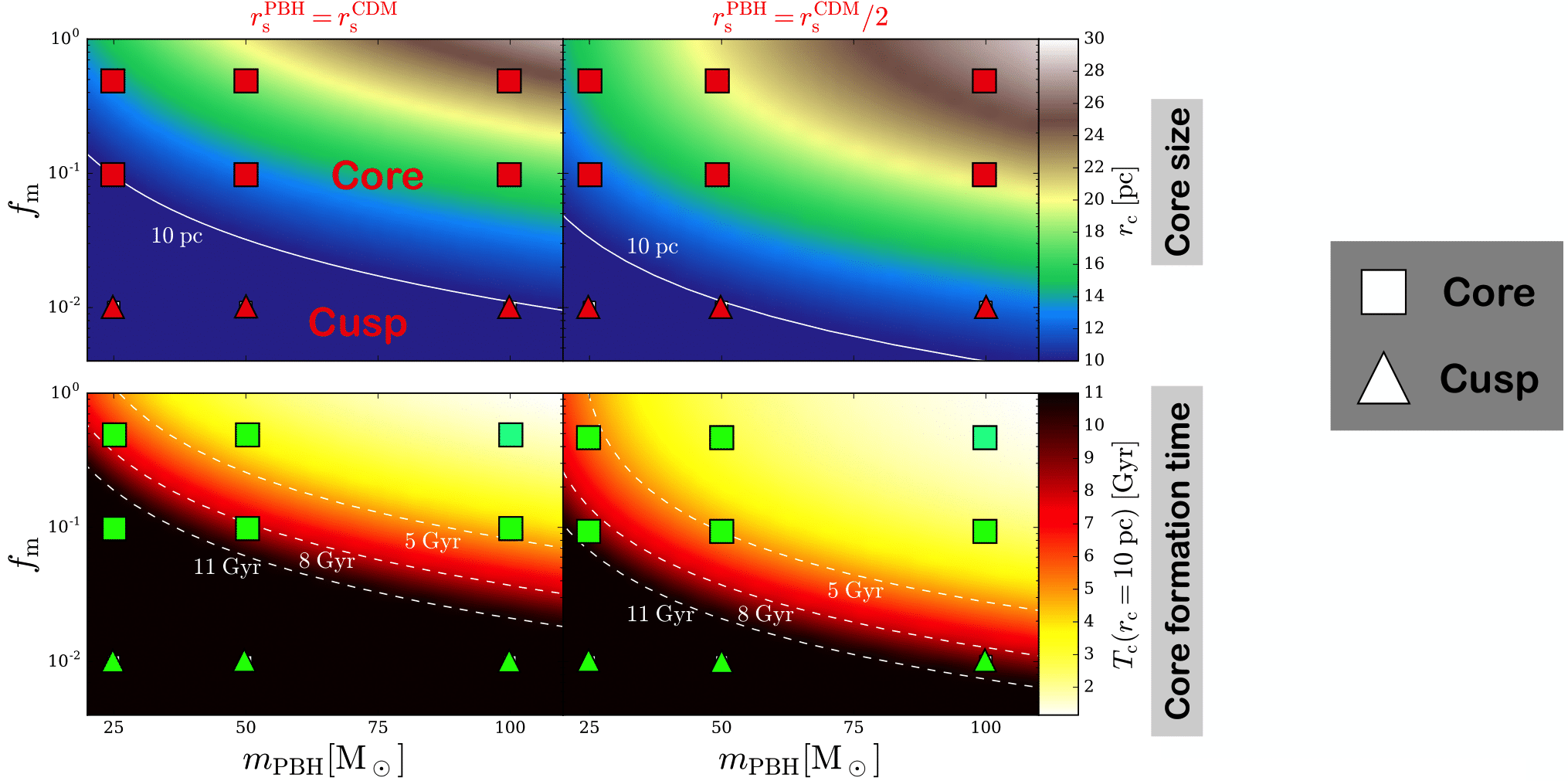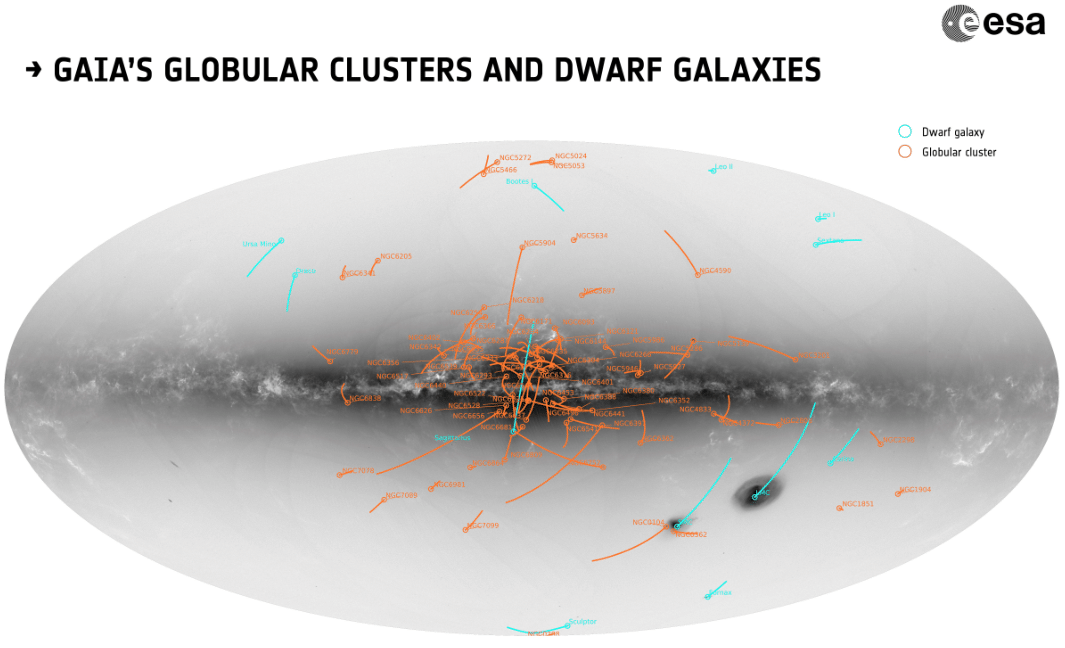Research

Past research
- The cusp-core problem
- A cuspy halo in Fornax is not ruled out by the dynamic of its globular clusters
- Embedding globular cluster in dark matter can solve the Fornax cusp-core problem
- An infalling satellite as the origin of the black offset in M31
- Subhalo sinking and off-center massive black holes in dwarf galaxies
- Primordial black holes as dark matter candidates: a new solution to the cusp-core problem
 During my thesis, I was focused on the dark matter (DM) theory that is considered to be the most successful and supported by observations: the cold dark matter (CDM) [Croft et al., 2002, Spergel et al., 2003]. One of the challenges of the CDM paradigm is the DM distribution in galaxies, commonly referred to as the "cusp-core problem". According to this theory, DM particles should be distributed densely at the centre of galaxies when their DM halo is formed [Dubinski & Carlberg 1991, Frenk et al. 1988,Gelb & Bertschinger 1994 ,Navarro et al. 1996 ,1997 ]. These are called cuspy halos because the density decreases as you move away from the galaxy centre. On the contrary, observations suggest that in some galaxies, such as Fornax, DM particles are not distributed in that way. One refers to it as a DM core because its density is lower and constant.
During my thesis, I was focused on the dark matter (DM) theory that is considered to be the most successful and supported by observations: the cold dark matter (CDM) [Croft et al., 2002, Spergel et al., 2003]. One of the challenges of the CDM paradigm is the DM distribution in galaxies, commonly referred to as the "cusp-core problem". According to this theory, DM particles should be distributed densely at the centre of galaxies when their DM halo is formed [Dubinski & Carlberg 1991, Frenk et al. 1988,Gelb & Bertschinger 1994 ,Navarro et al. 1996 ,1997 ]. These are called cuspy halos because the density decreases as you move away from the galaxy centre. On the contrary, observations suggest that in some galaxies, such as Fornax, DM particles are not distributed in that way. One refers to it as a DM core because its density is lower and constant.
Figure 1 - the cusp-core problem
Inner slope α of the density profiles as a function of the radius of the innermost point, within which α is measured. The theoretical slopes of a pseudo-isothermal halo is over-plotted with dotted lines for a core size of 0.5 (leftmost), 1 (centre), and 2 (rightmost) kpc. The solid line represents an NFW model [Navarro et al. 1996]. The pseudo-isothermal model is preferred over the NFW model to explain the observational data. The figure is taken from Oh et al. 2015.
 The dwarf galaxy Fornax, dominated by DM, has five GCs orbiting in its halo. The intensity of the dynamical friction, that these GCs experience, depends directly on the DM distribution within the galaxy centre, cusp or core. The first project of my thesis has consisted in determining which of these two distributions allows me to find the spatial and mass distribution of the 5 GCs observed today. It is nevertheless a complex problem to model, particularly because of the limitations of spatial and mass resolution in simulations. In addition to dynamical friction, other dynamical effects such as mass loss and dynamical self-friction occur, which make it a scientific challenge to reproduce the GC distribution observed today. Contrary to observations that preferred the hypothesis of a DM core, I have shown that GC dynamics do not exclude the presence of a cusp for the Fornax halo [Boldrini et al. 2019]. The case of Fornax is an extremely important challenge because it is promising to obtain robust constraints on the presence of cusps or cores in dwarf galaxies.
The dwarf galaxy Fornax, dominated by DM, has five GCs orbiting in its halo. The intensity of the dynamical friction, that these GCs experience, depends directly on the DM distribution within the galaxy centre, cusp or core. The first project of my thesis has consisted in determining which of these two distributions allows me to find the spatial and mass distribution of the 5 GCs observed today. It is nevertheless a complex problem to model, particularly because of the limitations of spatial and mass resolution in simulations. In addition to dynamical friction, other dynamical effects such as mass loss and dynamical self-friction occur, which make it a scientific challenge to reproduce the GC distribution observed today. Contrary to observations that preferred the hypothesis of a DM core, I have shown that GC dynamics do not exclude the presence of a cusp for the Fornax halo [Boldrini et al. 2019]. The case of Fornax is an extremely important challenge because it is promising to obtain robust constraints on the presence of cusps or cores in dwarf galaxies.
Figure 2 - Fornax and its GCs
However, I was not satisfied with this result. Within the CDM paradigm, I have considered on my personal initiative a scenario in which the GCs of Fornax have their own DM halos where they formed, like galaxies. Assuming that the GCs have this new dark component, their orbits will be completely modified by the dynamical friction process. That was the starting point of my second project; experimenting with the dynamics of these GCs embedded in DM in the Fornax galaxy. Even if the presence of DM in the GCs opens new insights for dynamics, it further complexifies the problem because of the additional constraints on the DM mass of the GCs at redshift z=0. I have shown that this original scenario explains the observations of these 5 GCs as well as the formation of a DM core for Fornax [Boldrini et al. 2020b]. Indeed, these GCs with a DM component will be sufficiently massive to alter the DM distribution and trigger a cusp-to-core transition at the galaxy centre. It was shown that the DM core size depends on the frequency of GC crossings. In addition, I find a good agreement with constraints on the DM masses of GCs as they lose a large fraction of their initial DM halos. Thus, these results provide circumstantial evidence for the universal existence of dark matter halos in GCs.
 It occurred to me to explore this friction phenomenon in the specific case of the Andromeda galaxy (M31). As a neighbour of our galaxy, M31 shows evidences for a recent merger with a satellite galaxy, such as the southern giant stream. It has been shown that a minor merger scenario leads to the formation of this stream in M31 [Fardal et al. 2006, Sadoun et al. 2014]. In addition, observations of M31 show that the central BH is currently off-centre. I have thoroughly studied this merger event to go further than previous works, which allowed me to show that the satellite also produces a DM core via dynamical friction during its passage close to the M31 centre [Boldrini et al. 2020d]. Consequently, it implies that cores could be a common feature of galaxies that have been initially cuspy but have accreted satellites on eccentric orbits. I also successfully demonstrated in full autonomy that the BH offset in M31 is also due to this merger [Boldrini 2020]. At the same time, I also ruled out that the Brownian motion of the MBH could be at the origin of this offset.
It occurred to me to explore this friction phenomenon in the specific case of the Andromeda galaxy (M31). As a neighbour of our galaxy, M31 shows evidences for a recent merger with a satellite galaxy, such as the southern giant stream. It has been shown that a minor merger scenario leads to the formation of this stream in M31 [Fardal et al. 2006, Sadoun et al. 2014]. In addition, observations of M31 show that the central BH is currently off-centre. I have thoroughly studied this merger event to go further than previous works, which allowed me to show that the satellite also produces a DM core via dynamical friction during its passage close to the M31 centre [Boldrini et al. 2020d]. Consequently, it implies that cores could be a common feature of galaxies that have been initially cuspy but have accreted satellites on eccentric orbits. I also successfully demonstrated in full autonomy that the BH offset in M31 is also due to this merger [Boldrini 2020]. At the same time, I also ruled out that the Brownian motion of the MBH could be at the origin of this offset.
Figure 4 - Zoom on the BH offset
M31 BH projected radius from simulation and orbit integration between 1.35 and 2.15 Gyr. We take initial conditions for the MBH at resolved scales (above 10 pc) from the simulation in order to reduce our numerical noise. The MBH is still offset and is orbiting with a mean projected pericentre of 0.45 pc, which is similar to the value of 0.26 pc derived from observations (Kormendy & Bender 1999). The best match between the observed and simulated stream is obtained at 2.1 Gyr, which corresponds to a BH projected pericentre of 0.39 pc for orbital integrations from 1.38 Gyr. The figure is taken from Boldrini et al. 2020d.
 Once this BH offset was explained for M31, I still had to investigate this offset phenomenon in dwarf galaxies in general. Following my intuition, I have shown that when DM substructures pass near the galaxy centre, it results an off-centre BH due to the heating of the central region [Boldrini et al. 2020c]. Indeed, at redshift z=3, the average number of subhalo accretions is high (∼4 per Gyr). Thus, the heating by subhalos and the subsequent kick to the central MBH provides a new mechanism that contributes to explain observed off-center BHs in dwarf galaxies. Moreover, for the first time, I came up with the idea that the offset of the BH can quench his feedback [Boldrini et al. 2020c]. One of the major implications of this result is the questioning of the formation of DM cores via the feedback from the BH in these galaxies. As BH feedback consists of energy injection into halos, this latter is commonly invoked as a mechanism for core formation. However, BHs accrete gas inefficiently away from the galaxy centre as gas clumps are centrally located [Smith et al. 2018]. Then, the conditions required to alter the deep potential of galaxies appear to be missing.
Once this BH offset was explained for M31, I still had to investigate this offset phenomenon in dwarf galaxies in general. Following my intuition, I have shown that when DM substructures pass near the galaxy centre, it results an off-centre BH due to the heating of the central region [Boldrini et al. 2020c]. Indeed, at redshift z=3, the average number of subhalo accretions is high (∼4 per Gyr). Thus, the heating by subhalos and the subsequent kick to the central MBH provides a new mechanism that contributes to explain observed off-center BHs in dwarf galaxies. Moreover, for the first time, I came up with the idea that the offset of the BH can quench his feedback [Boldrini et al. 2020c]. One of the major implications of this result is the questioning of the formation of DM cores via the feedback from the BH in these galaxies. As BH feedback consists of energy injection into halos, this latter is commonly invoked as a mechanism for core formation. However, BHs accrete gas inefficiently away from the galaxy centre as gas clumps are centrally located [Smith et al. 2018]. Then, the conditions required to alter the deep potential of galaxies appear to be missing.
Figure 5 - Off-center MBHs:
BH orbital radius over 12 Gyr for different subhalo numbers and masses. This radius corresponds to the distance between the BH and the mass centre of the dwarf stellar component. The reason why we centered on the stellar component is precisely because observations establish displacements of MBH from the stellar component. Subhalo crossings heat the central regions and more particularly affect the MBH via dynamical friction. Indeed, subhalos add energy to the MBH, causing it to leave the galaxy centre. In the absence of perturbers, the MBH remains at the centre of the dwarf galaxy. This scenario ensures the stability of the BH against numerical effects (black curve). However, taking into account the subhalo interactions results in a kick of the MBH to tens of parsecs from the galaxy centre, depending sensitively on the number of subhalos and on their masses. We assume that the MBH is off-center when its orbital radius is greater than the orbital radius of the MBH in the absence of any perturbers. The figure is taken from Boldrini et al. 2020c.
 In my previous works, I have relied on the CDM paradigm. However, there are many alternative DM theories such as warm DM, self-interacting DM and fuzzy DM. One is that the dark matter is not cold. Cores can be produced in DM halos by particle physics effects if the dark matter particles have specific properties that differ from those of the standard CDM candidates. It was also proposed that CDM could be partially composed of BHs [Zel’dovich and Novikov 1967, Hawking 1971]. Since these BHs could naturally be produced in the early Universe via cosmic inflation, we refer to them as primordial black holes (PBHs). In my last project, I have shown that the presence of a PBH population, in addition to CDM particles, in dwarf galaxies perturbs the distribution of DM in the central region [Boldrini et al. 2020a]. Being more massive than DM particles, PBHs fall to the galaxy centre due to dynamical friction and then push the DM particles out of the central region. In PBH+CDM halos, another important dynamical effect is two-body relaxation between PBHs, which enhances the CDM particle migration. As such, I have demonstrated that the DM density in the center decreases leading to the formation of a DM core with PBHs in the mass window consistent with the LIGO detections. This work therefore argues that PBHs provide a solution to the cusp-core problem at the center of dwarf galaxies [Boldrini et al. 2020a]. Indeed, DM cores occur naturally in halos comprised of CDM and PBHs, without the need to invoke baryonic processes, but this mechanism requires a lower limit on the PBH mass fraction of 1% of the total dwarf galaxy DM content.
In my previous works, I have relied on the CDM paradigm. However, there are many alternative DM theories such as warm DM, self-interacting DM and fuzzy DM. One is that the dark matter is not cold. Cores can be produced in DM halos by particle physics effects if the dark matter particles have specific properties that differ from those of the standard CDM candidates. It was also proposed that CDM could be partially composed of BHs [Zel’dovich and Novikov 1967, Hawking 1971]. Since these BHs could naturally be produced in the early Universe via cosmic inflation, we refer to them as primordial black holes (PBHs). In my last project, I have shown that the presence of a PBH population, in addition to CDM particles, in dwarf galaxies perturbs the distribution of DM in the central region [Boldrini et al. 2020a]. Being more massive than DM particles, PBHs fall to the galaxy centre due to dynamical friction and then push the DM particles out of the central region. In PBH+CDM halos, another important dynamical effect is two-body relaxation between PBHs, which enhances the CDM particle migration. As such, I have demonstrated that the DM density in the center decreases leading to the formation of a DM core with PBHs in the mass window consistent with the LIGO detections. This work therefore argues that PBHs provide a solution to the cusp-core problem at the center of dwarf galaxies [Boldrini et al. 2020a]. Indeed, DM cores occur naturally in halos comprised of CDM and PBHs, without the need to invoke baryonic processes, but this mechanism requires a lower limit on the PBH mass fraction of 1% of the total dwarf galaxy DM content.
Figure 6 - Core size and core formation time
Core size (top panels) and core formation time (bottom panels) maps in (fm, mPBH) space for both scale radii. The white line in top panels, which marks the limit of the cusp-to-core transition, is consistent with the shape of the CDM distribution from the simulations (triangles and squares) under this latter assumption. At least a mass fraction of 1% is needed to induce cores in PBH+CDM halos depending on the PBH mass and rPBHs . The core formation time maps (bottom panels) reveal that the cusp-to-core transition takes between 1 and 8 Gyr to occur depending on the parameters. Enhancing the density of PBHs in the central region accelerate the formation of cores. The figure is taken from Boldrini et al. 2020a.
Research interests
- Prospect for Gaia survey: Globular clusters are embedded in dark matter
- Central massive black hole as dynamical footprints of alternative dark matter theories?
Before considering alternative DM theories, it is necessary to learn more about the nature of GCs within the CDM paradigm. Currently, there is no clear consensus on the formation of GCs. One of the formation scenario is that these clusters have been formed at the time of reionization in DM halos that later merge to become a part of the present-day host galaxy. Until now, these DM halos have not been detected. One of the reasons is that GCs orbiting in the inner regions of the Galaxy may lose a large fraction of any DM mass due to tidal effects. However, the clusters will retain a dynamical memory of this dark component. Indeed, observational signatures in the projected velocity dispersion profile at large distances and also in the outer surface density profile of GCs will remain. Our galaxy is full of data about GCs. Thanks to the recent Gaia DR2 survey, we now have access to the 3D spatial positions and velocities of the 150 clusters populating the Milky Way. Accuracy will only increase with the new data from the next revealed Gaia DR3, available at the end of the year. My approach aims to combine numerical simulations, theoretical predictions as well as observational data. By carefully choosing the GCs of the Milky Way, I plan to detect the dynamical signature of the DM in GCs, if it has not been stripped.

A dynamical DM footprint, which will have detectable observational consequences, is dynamical friction. This drag force will dictate not only the observed position but also the survival of orbiting objects in the DM field of galaxies. During my thesis, I have explored sub-galactic dynamics mainly within the CDM paradigm. This is why I plan to explore alternative DM theories such as self-interacting and fuzzy DM in specific scenarios in order to constrain or validate them. Indeed, in these alternative theories, the DM halo is expected to have a central constant density or « core ». The presence of a DM core will have dynamical consequences for orbiting objects, in particular to lengthen the infall time. First, I envisage to explore the dynamics of GCs in a fuzzy DM and self-interacting universe to obtain observational constraints on stellar tidal arms, the stellar velocity dispersion and the fraction of observed clusters. Moreover, the location of massive BHs at the centre of dwarf galaxies is also important to the study of DM microphysics. Since in these alternative theories the dynamical friction time is longer, a larger population of off-centre BHs is expected than in the CDM framework. My objective is to verify this prediction which can be confirmed by LISA in the coming years.
Moreover, at the sub-galactic scale, which is typically on the order of a few kpc, baryons start to play an important role. Numerous baryonic processes, such as stellar and BH feedback, transfer energy to the central region of galaxies. For instance, since DM interacts only gravitationally, baryons can affect it through the gravitational potential. Therefore, adding dissipative hydrodynamics in my model is the next natural step in my research in order to check the predictions from my DM-only simulations. I have shed in light that one consequence of off-centre BHs during early epochs of dwarf galaxies is to quench any BH feedback. The inclusion of baryonic physics will make it possible to validate this prediction, which could have a major impact on the growth of BHs within galaxies. Besides, taking into account the coupling between DM and baryons seems crucial for the exploration of alternative DM theories.
